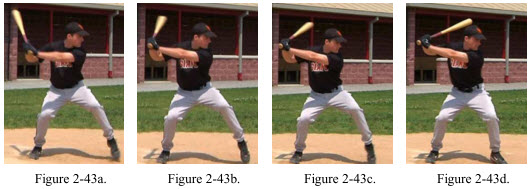The Little League® Tee Ball program is focused on bringing fun, fitness and fundamentals to its youngest players and newest volunteers. As a part of this program, Little League partnered with SKLZ to provide Tee Ball coaches with online training related to various components of the program.
This month, we take a look at teaching one of the most difficult skills for a tee baller to master - catching the ball. The online training segment below covers a three-step teaching method.
The method consists of:
Teaching the basket catch
Teaching to catch the ball with the hands up
Teaching to catch the ball with two hands
You can view this month’s online training segment by clicking on the images below.
Source & video: http://www.littleleaguecoach.org/home.aspx?article=1258
Monday, September 28, 2015
Friday, September 11, 2015
Baseball Swing Mechanics: Cocking of the Wrists
Cocking of the wrists is an action the hands perform on the bat-handle at the very end of the loading phase and into the first part of the launching phase. It’s purpose is to break inertia, or prevent the bat from coming to a dead stop, so as to facilitate a rapid recoiling effect with the bat-head at the end of the player’s furthest backswing.
Now up until this point of the swing, the wrists and hands have not produced any significant action on the bat-handle, and subsequently the bat-head, other than holding the bat in a steady and firm position. But the batter’s body and hand positions shown in Figure 2-40 is an important reference point because this is where the action of the hands and wrists begin to take effect on the bat handle. Or in other words, this is where the cocking of the wrists begins.
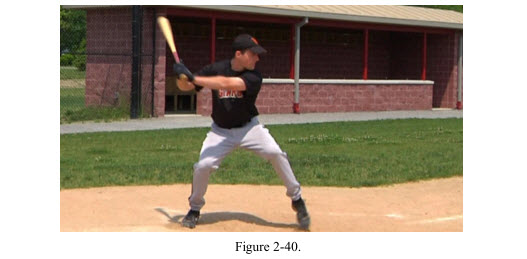 Now as I just mentioned earlier, the purpose of the cocking of the wrists is to break inertia, or prevent the bat from coming to a dead stop, so as to facilitate a rapid recoiling effect with the bat-head at the end of the player’s furthest backswing. So, let’s define our next reference point, and that is, the player’s further backswing.
Now as I just mentioned earlier, the purpose of the cocking of the wrists is to break inertia, or prevent the bat from coming to a dead stop, so as to facilitate a rapid recoiling effect with the bat-head at the end of the player’s furthest backswing. So, let’s define our next reference point, and that is, the player’s further backswing.
As we watch the swing develop in Figures 2-41a through 2-41d we can now see that the player’s furthest backswing ends in Figure 2-41d.
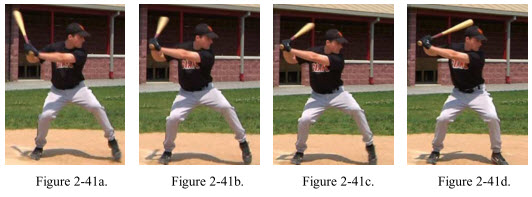 The furthest backswing position is simply a point in the swing where the head of the bat does not travel any further away in the opposite direction of the intended path of the swing. It also represents the position where the cocking of the wrists ends or where the wrists are fully cocked.
The furthest backswing position is simply a point in the swing where the head of the bat does not travel any further away in the opposite direction of the intended path of the swing. It also represents the position where the cocking of the wrists ends or where the wrists are fully cocked.
So to recap here a bit, let’s again focus on these two bat-head positions side by side. Notice the position of the bat-head in Figure 2-42a where the cocking of the wrists begins, and now notice the position of the bat-head in Figure 2-42b where the cocking of the wrists ends.

Now that we have seen the two different bat-head positions that define the starting and ending positions where cocking the wrists takes place, let’s take a closer look at the action that the hands and wrists have on the bat-handle that makes this happen.
We will focus our attention first on the player’s right hand shown again in Figures 2-43a through 2-43d. The main action that the right hand and wrist are performing on the bat handle during this movement is called pronation, which interestingly enough, occurs through muscles acting in the forearm near the right elbow and wrist. And so the correct name for this movement seen in the right hand and wrist is called elbow pronation.
It is by pronating the right elbow where the right hand and wrist turn so that the palm of the right hand starts to turn inward toward the ground and this helps to push the bat-head to its furthest backswing position. See Figure 2-44.
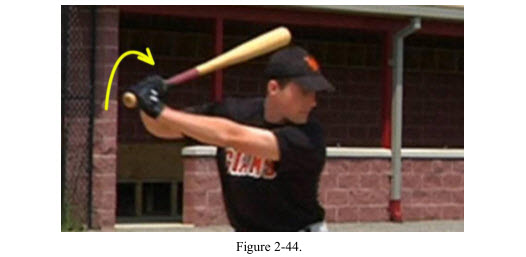
Now keep in mind that this is a relatively small movement taking place in comparison to what the shoulders and upper arms are going through and so you may not pick up on it the first time by simply looking at the right hand and wrist. However, there is just enough of this pronation taking place in the right elbow to cause the right hand and wrist to turn so that the palm of the right hand starts to turn in toward the batter and this helps to push the bat-head to its furthest backswing position.
The muscles involved with elbow or forearm pronation are the Pronator Teres and Pronator Quadratus. See Figure 2-45.
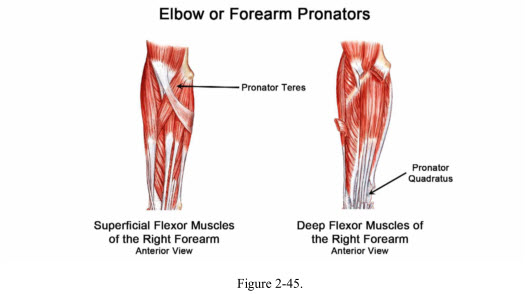
Now let’s focus our attention on the player’s left hand in Figures 2-46a through 2-46d. The main action that the player’s left hand and wrist are performing on the bat-handle during the cocking of the wrists is called radial deviation.
Radial deviation is a movement that occurs within the wrist where the entire hand moves toward the thumb. You may also think of it as trying to get your hand and thumb to move in a direction where the thumb tries to touch the side of your forearm as seen by the arrow shown in Figure 2-47.
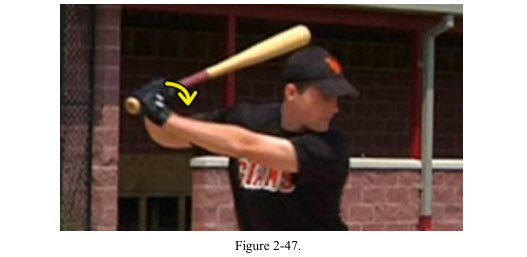
It is by radially deviating the left hand and wrist that helps to bring the bat-handle, and consequently the bat-head, to the player’s furthest backswing position.
And just like the right hand and wrist, keep in mind that this is a relatively small movement taking place in comparison to what the shoulders and upper arms are going through and so you may not pick up on it the first time by simply looking at the left hand and wrist. However, there is just enough of this radial deviation taking place to help move the bat-head to its furthest backswing position.
The muscles involved with radially deviating the left hand and wrist are the Extensor Carpi Radialis Longus, Extensor Carpi Radialis Brevis, and Flexor Carpi Radialis. See Figure 2-48.
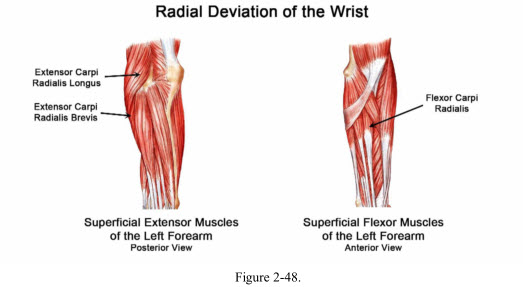
The contraction of the elbow pronators in the right forearm and radial deviators in the left wrist moves the bat-head to the player’s furthest backswing position. What this movement does is temporarily loads, or stretches, the antagonistic muscles in the right forearm, which are the right elbow supinators, and in left wrist, which are the left ulnar deviators, just long enough so that the player can time the stretching in these muscles, and subsequent contracting of them, to add extra momentum and power to his swing. See Figures 2-49a through 2-49d.
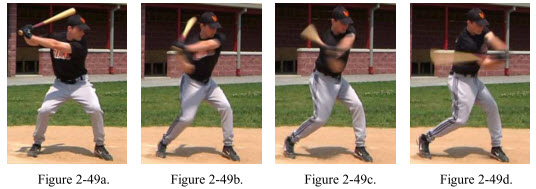
This is what is known as the myotatic reflex which is a muscle contraction in response to it first being rapidly stretched, i.e., loaded. It is a very powerful reflex within the muscle that can significantly increase the speed and strength in which it contracts. This is because it essentially adds a ‘running start’ in the direction of the intended path of contraction.
Now the myotatic (stretch) reflex is only usable for about a half of a second or less after a muscle has been stretched and then it dampens out, or weakens, and is no longer available. So the key to using this reflex within a stretched muscle, such as what takes place during the cocking of the wrists, is to time it at the precise moment that you need it.
Now these stretch reflexes occur not only in the muscles involved with cocking the wrists, but in every other muscle that was stretched so far during the loading (stretching) phase. This includes the muscles around both shoulders that were stretched during the backward movement of the shoulders and arms, the lateral spine rotators during the backward rotation of the spine, the hip extensors, knee extensors and ankle plantar-flexors during the beginning of the timing step and the external hip rotators during the cocking of the hips.
So these stretch reflexes play a very significant role in your ability to swing the bat harder and faster. Simply put, you couldn’t swing the bat very hard or fast without them. And since they are only available within the muscle for less than a second, the timing of their creation and use is not only essential to making contact with the ball, but doing so with power.
Source: http://baseballswingmechanics.com/06a-cocking-wrists-text/
Now up until this point of the swing, the wrists and hands have not produced any significant action on the bat-handle, and subsequently the bat-head, other than holding the bat in a steady and firm position. But the batter’s body and hand positions shown in Figure 2-40 is an important reference point because this is where the action of the hands and wrists begin to take effect on the bat handle. Or in other words, this is where the cocking of the wrists begins.

As we watch the swing develop in Figures 2-41a through 2-41d we can now see that the player’s furthest backswing ends in Figure 2-41d.

So to recap here a bit, let’s again focus on these two bat-head positions side by side. Notice the position of the bat-head in Figure 2-42a where the cocking of the wrists begins, and now notice the position of the bat-head in Figure 2-42b where the cocking of the wrists ends.

Now that we have seen the two different bat-head positions that define the starting and ending positions where cocking the wrists takes place, let’s take a closer look at the action that the hands and wrists have on the bat-handle that makes this happen.
We will focus our attention first on the player’s right hand shown again in Figures 2-43a through 2-43d. The main action that the right hand and wrist are performing on the bat handle during this movement is called pronation, which interestingly enough, occurs through muscles acting in the forearm near the right elbow and wrist. And so the correct name for this movement seen in the right hand and wrist is called elbow pronation.
It is by pronating the right elbow where the right hand and wrist turn so that the palm of the right hand starts to turn inward toward the ground and this helps to push the bat-head to its furthest backswing position. See Figure 2-44.

Now keep in mind that this is a relatively small movement taking place in comparison to what the shoulders and upper arms are going through and so you may not pick up on it the first time by simply looking at the right hand and wrist. However, there is just enough of this pronation taking place in the right elbow to cause the right hand and wrist to turn so that the palm of the right hand starts to turn in toward the batter and this helps to push the bat-head to its furthest backswing position.
The muscles involved with elbow or forearm pronation are the Pronator Teres and Pronator Quadratus. See Figure 2-45.

Now let’s focus our attention on the player’s left hand in Figures 2-46a through 2-46d. The main action that the player’s left hand and wrist are performing on the bat-handle during the cocking of the wrists is called radial deviation.
Radial deviation is a movement that occurs within the wrist where the entire hand moves toward the thumb. You may also think of it as trying to get your hand and thumb to move in a direction where the thumb tries to touch the side of your forearm as seen by the arrow shown in Figure 2-47.

It is by radially deviating the left hand and wrist that helps to bring the bat-handle, and consequently the bat-head, to the player’s furthest backswing position.
And just like the right hand and wrist, keep in mind that this is a relatively small movement taking place in comparison to what the shoulders and upper arms are going through and so you may not pick up on it the first time by simply looking at the left hand and wrist. However, there is just enough of this radial deviation taking place to help move the bat-head to its furthest backswing position.
The muscles involved with radially deviating the left hand and wrist are the Extensor Carpi Radialis Longus, Extensor Carpi Radialis Brevis, and Flexor Carpi Radialis. See Figure 2-48.

The contraction of the elbow pronators in the right forearm and radial deviators in the left wrist moves the bat-head to the player’s furthest backswing position. What this movement does is temporarily loads, or stretches, the antagonistic muscles in the right forearm, which are the right elbow supinators, and in left wrist, which are the left ulnar deviators, just long enough so that the player can time the stretching in these muscles, and subsequent contracting of them, to add extra momentum and power to his swing. See Figures 2-49a through 2-49d.

This is what is known as the myotatic reflex which is a muscle contraction in response to it first being rapidly stretched, i.e., loaded. It is a very powerful reflex within the muscle that can significantly increase the speed and strength in which it contracts. This is because it essentially adds a ‘running start’ in the direction of the intended path of contraction.
Now the myotatic (stretch) reflex is only usable for about a half of a second or less after a muscle has been stretched and then it dampens out, or weakens, and is no longer available. So the key to using this reflex within a stretched muscle, such as what takes place during the cocking of the wrists, is to time it at the precise moment that you need it.
Now these stretch reflexes occur not only in the muscles involved with cocking the wrists, but in every other muscle that was stretched so far during the loading (stretching) phase. This includes the muscles around both shoulders that were stretched during the backward movement of the shoulders and arms, the lateral spine rotators during the backward rotation of the spine, the hip extensors, knee extensors and ankle plantar-flexors during the beginning of the timing step and the external hip rotators during the cocking of the hips.
So these stretch reflexes play a very significant role in your ability to swing the bat harder and faster. Simply put, you couldn’t swing the bat very hard or fast without them. And since they are only available within the muscle for less than a second, the timing of their creation and use is not only essential to making contact with the ball, but doing so with power.
Source: http://baseballswingmechanics.com/06a-cocking-wrists-text/
Friday, September 4, 2015
Drill: One Knee Hitting
For years I have believed in one knee hitting drills. Today I am going to break down why hitting drills off of one knee are so important for understanding rotational mechanics.

Watch this video through once, then watch it again. Pause the video at Pedroia's point of contact. This picture you are looking at looks exactly like the one knee hitting drill I have all of my players execute daily. The goal of the one knee hitting drill is to focus on getting your back hip and shoulder squared up to the baseball.
The reason one knee hitting drills are so important for amateur players to execute daily is because it teaches you how to turn. Like I said in the last article, most 21st century hitters completely disconnect their arms from their lower half which produces slow, all-arm swings. The goal of hitting is to get your back hip, knee and shoulder squared up to the baseball. When we get our back hip and back knee squared up to the baseball we are using the big muscles in our body to produce bat speed.
Watch the Pedroia video one more time. Take a look at his frontside at the point of contact. His frontside is completely locked and solid in the ground. This solid frontside is what allows Pedroia to turn his back hip, back knee and back shoulder around to get them squared up to the baseball.
The one knee hitting drill is crucial for understanding how to turn and stay connected throughout. The back elbow should naturally tuck to the body for a tight turn. Figure skaters are a great example of how to stay connected throughout a turn. When competitive figure skaters are turning slowly, their arms are extended. When they want to get a high score or win a competition, they tuck their arms close to their body and can now spin a whole lot faster. The same is true in baseball. The back elbow must tuck to the body in for a tight, efficient turn to the point of contact. Take a look at the examples below. Stay connected so centrifugal force does not force you to just throw your hands.


When on a knee, hitters will find that if they just throw their hands they will produce no bat speed. After 15-20 reps off a knee, most amateur players begin to feel what rotational hitting is like. Usually amateur players start out by rolling over the first couple reps because they are used to going to get the baseball with their hands instead of turning their body as one. Variations of the one knee drill include just using a top or bottom hand.
The analogy I give all of my students is that of a boxer. A boxer's punch, if fully extended, is no where near as powerful as a jab (close to the body). I tell all of my players to let the baseball travel to "throw the jab". The power in hitting, just like in boxing, is close to your body. The farther out we reach to punch or swing, the less power and bat speed we will have. One knee hitting drills teach hitters to let the ball travel because if you go out and hit the ball with your hands you will have a 'ground ball' type round.
Source: http://www.coresavvybaseball.com/core-savvy-articles/csb-live-or-die-by-one-knee-hitting

Watch this video through once, then watch it again. Pause the video at Pedroia's point of contact. This picture you are looking at looks exactly like the one knee hitting drill I have all of my players execute daily. The goal of the one knee hitting drill is to focus on getting your back hip and shoulder squared up to the baseball.
The reason one knee hitting drills are so important for amateur players to execute daily is because it teaches you how to turn. Like I said in the last article, most 21st century hitters completely disconnect their arms from their lower half which produces slow, all-arm swings. The goal of hitting is to get your back hip, knee and shoulder squared up to the baseball. When we get our back hip and back knee squared up to the baseball we are using the big muscles in our body to produce bat speed.
Watch the Pedroia video one more time. Take a look at his frontside at the point of contact. His frontside is completely locked and solid in the ground. This solid frontside is what allows Pedroia to turn his back hip, back knee and back shoulder around to get them squared up to the baseball.
The one knee hitting drill is crucial for understanding how to turn and stay connected throughout. The back elbow should naturally tuck to the body for a tight turn. Figure skaters are a great example of how to stay connected throughout a turn. When competitive figure skaters are turning slowly, their arms are extended. When they want to get a high score or win a competition, they tuck their arms close to their body and can now spin a whole lot faster. The same is true in baseball. The back elbow must tuck to the body in for a tight, efficient turn to the point of contact. Take a look at the examples below. Stay connected so centrifugal force does not force you to just throw your hands.


When on a knee, hitters will find that if they just throw their hands they will produce no bat speed. After 15-20 reps off a knee, most amateur players begin to feel what rotational hitting is like. Usually amateur players start out by rolling over the first couple reps because they are used to going to get the baseball with their hands instead of turning their body as one. Variations of the one knee drill include just using a top or bottom hand.
The analogy I give all of my students is that of a boxer. A boxer's punch, if fully extended, is no where near as powerful as a jab (close to the body). I tell all of my players to let the baseball travel to "throw the jab". The power in hitting, just like in boxing, is close to your body. The farther out we reach to punch or swing, the less power and bat speed we will have. One knee hitting drills teach hitters to let the ball travel because if you go out and hit the ball with your hands you will have a 'ground ball' type round.
Source: http://www.coresavvybaseball.com/core-savvy-articles/csb-live-or-die-by-one-knee-hitting
Subscribe to:
Posts (Atom)






